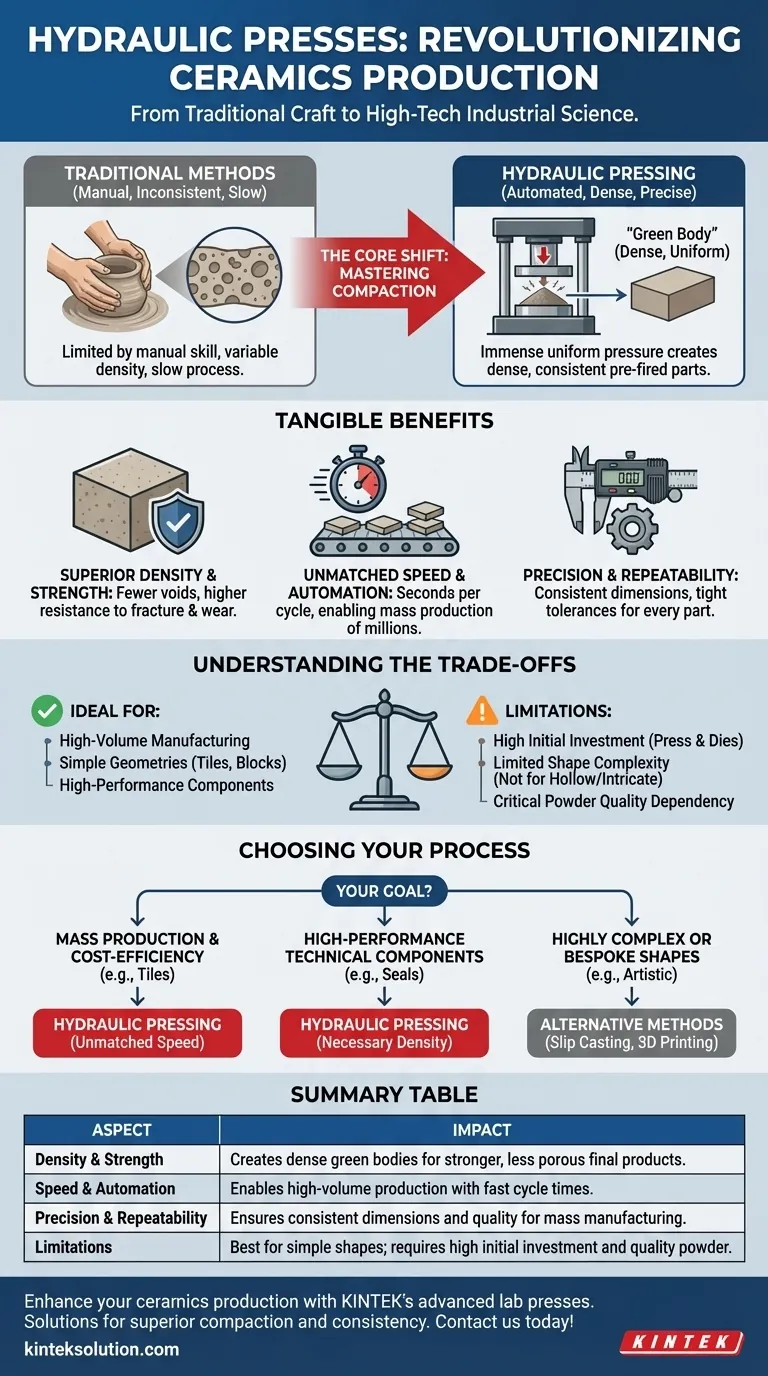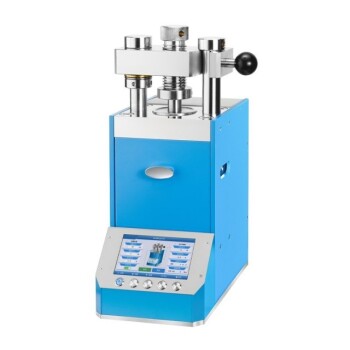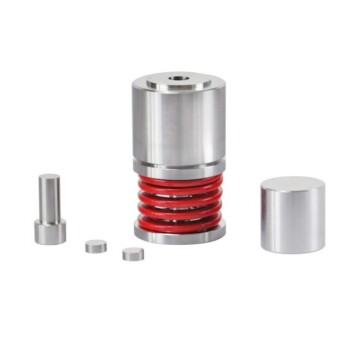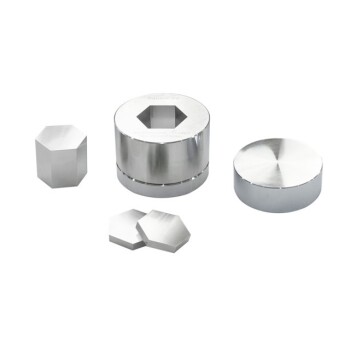In short, hydraulic presses have revolutionized ceramics production by enabling the rapid, automated, and highly precise compaction of ceramic powders into dense forms. This industrial method replaces slower, less consistent traditional shaping techniques, paving the way for mass-produced, high-performance ceramic goods like tiles, bricks, and advanced technical components.
The core shift was not merely in shaping but in mastering compaction. By applying immense and uniform pressure to ceramic powders before firing, hydraulic presses create exceptionally dense "green bodies," leading to final products with superior strength, precision, and consistency at a scale previously unimaginable.
From Manual Craft to Industrial Science
Traditionally, shaping ceramics was a labor-intensive process, often relying on manual skill. While effective for artistic or small-scale production, these methods faced significant limitations when applied to the demands of modern industry.
The Traditional Challenge: Inconsistent Density
Methods like slip casting or manual molding are excellent for complex shapes but struggle to produce parts with perfectly uniform density. This can result in internal voids or weaknesses that compromise the strength and performance of the final fired product.
Furthermore, these processes are slow and difficult to automate, making true mass production of high-precision parts inefficient and costly.
The Hydraulic Solution: Unprecedented Compaction
A hydraulic press exerts immense, evenly distributed force on ceramic powder held within a die. This process, known as cold pressing or compaction, forces the individual grains of powder into tight, intimate contact.
The result is a pre-fired part, often called a "green body," that is already remarkably dense and solid. Think of it as packing loose snow into a hard, solid snowball—the press does this with extreme force and perfect uniformity.
The Tangible Benefits of Hydraulic Pressing
This shift to high-pressure compaction introduces several transformative advantages that are now foundational to the modern ceramics industry.
Superior Density and Strength
A denser green body leads directly to a stronger, less porous final product after it is fired in a kiln. With fewer internal voids, the finished ceramic is far more resistant to fractures, wear, and chemical attack, making it suitable for demanding applications.
Unmatched Speed and Automation
A hydraulic press can form a ceramic tile or brick in a matter of seconds. This cycle time is orders of magnitude faster than traditional casting or molding methods, enabling the continuous, automated production of millions of units.
Precision and Repeatability
Because the process is controlled by a precisely machined die and a computer-controlled press, every part produced is virtually identical. This dimensional accuracy is critical for products like floor tiles that must fit together perfectly or technical components that must meet strict engineering tolerances.
Understanding the Trade-offs
While revolutionary, hydraulic pressing is not a universal solution. Its advantages come with specific limitations that make it ideal for some applications but unsuitable for others.
High Initial Investment
Hydraulic presses and the associated tooling (dies) represent a significant capital expenditure. This makes the process best suited for high-volume manufacturing where the cost can be amortized over millions of parts.
Limitations in Shape Complexity
Pressing is most effective for producing parts with relatively simple geometries, such as tiles, discs, blocks, and cylinders. Creating complex, hollow, or intricate shapes is extremely difficult and often better suited to slip casting or ceramic 3D printing.
Criticality of Powder Quality
The entire process depends on using a high-quality, free-flowing ceramic powder with a consistent particle size. Poor powder preparation can lead to defects, uneven density, and failure of the final part.
Making the Right Choice for Your Goal
Selecting the correct manufacturing process depends entirely on the specific requirements of your final product.
- If your primary focus is mass production and cost-efficiency (e.g., tiles, bricks): Hydraulic pressing is the definitive industry standard due to its unmatched speed and repeatability.
- If your primary focus is high-performance technical components (e.g., seals, insulators, armor): Hydraulic pressing provides the necessary density and material integrity required for extreme applications.
- If your primary focus is highly complex or bespoke shapes (e.g., artistic pieces, intricate prototypes): Methods like slip casting or additive manufacturing offer greater design freedom.
By mastering the science of compaction, hydraulic presses transformed ceramics from a traditional craft into a high-tech engineering discipline.
Summary Table:
| Aspect | Impact |
|---|---|
| Density & Strength | Creates dense green bodies for stronger, less porous final products. |
| Speed & Automation | Enables high-volume production with fast cycle times. |
| Precision & Repeatability | Ensures consistent dimensions and quality for mass manufacturing. |
| Limitations | Best for simple shapes; requires high initial investment and quality powder. |
Ready to enhance your ceramics production with advanced hydraulic presses? KINTEK specializes in lab press machines, including automatic lab presses, isostatic presses, and heated lab presses, designed to meet the precise needs of laboratories and industrial settings. Our equipment delivers superior compaction, automation, and consistency for high-performance ceramic products. Contact us today to discuss how our solutions can boost your efficiency and quality!
Visual Guide

Related Products
- Laboratory Hydraulic Press 2T Lab Pellet Press for KBR FTIR
- Laboratory Hydraulic Press Lab Pellet Press Button Battery Press
- Automatic Lab Cold Isostatic Pressing CIP Machine
- Lab Round Bidirectional Press Mold
- Manual Heated Hydraulic Lab Press with Integrated Hot Plates Hydraulic Press Machine
People Also Ask
- How is a hydraulic press used in sample preparation for spectroscopy? Achieve Accurate and Homogeneous Sample Pellets
- What are some laboratory applications of hydraulic presses? Boost Precision in Sample Prep and Testing
- What are the benefits of reduced physical effort and space requirements in hydraulic mini presses? Boost Lab Efficiency and Flexibility
- What are the advantages of using the hydraulic portable press for making KBr pellets? Achieve Superior FT-IR Sample Prep
- How are hydraulic presses used in spectroscopy and compositional determination? Enhance Accuracy in FTIR and XRF Analysis



















